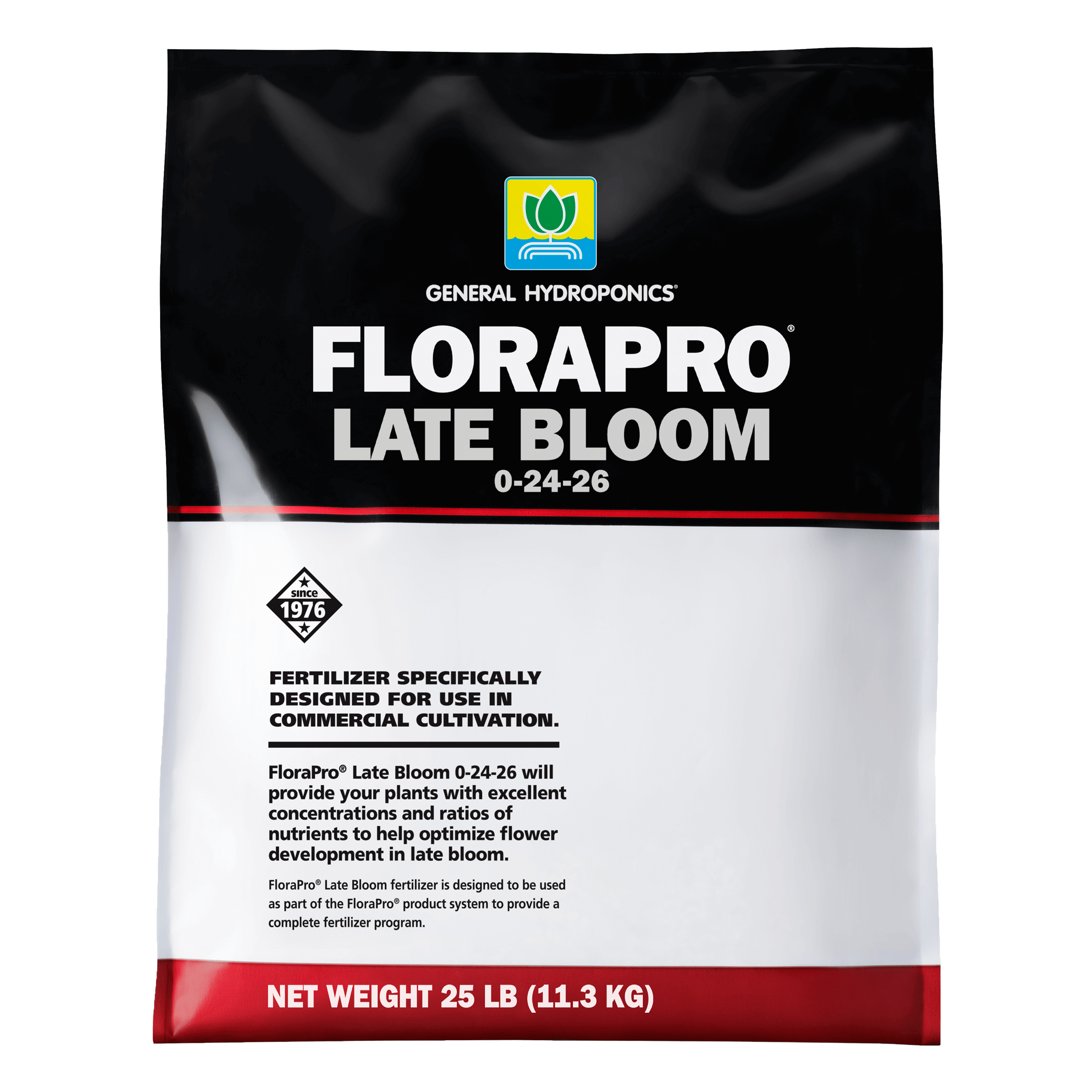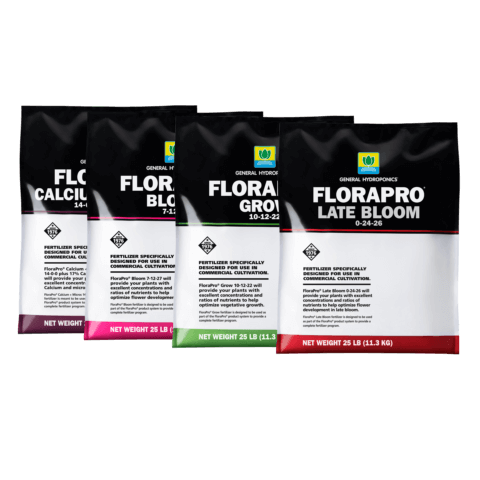FloraPro™ Late Bloom
General HydroponicsFloraPro™ Late Bloom is part of the FloraPro™ nutrient system. It can be used in combination with FloraPro™ Bloom or as a replacement for FloraPro™ Bloom based on your plant’s nitrogen needs. Our unique formulations and methodologies help to produce superior results in large-scale operations. Designed from the ground up for fertilizer injection systems, FloraPro™ is easy to use and highly water-soluble. Our complete and balanced formula is cost-effective, scalable, and consistent to meet the high standards of a competitive industry.
FloraPro™ Late Bloom is a zero nitrogen bud finishing product with high potassium and magnesium sulfate to encourage prolific flower development and allow growers more versatility to be able to fade nitrogen during the bloom phase.
This will allow growers of all kinds to customize their fertilizer program to their specific needs.
Technical-Grade Nutrients Designed for Hydroponic Commercial Cultivation
FloraPro™ is specially formulated for high-value production crops where results and consistency are paramount. Our unique formulation and methodology produce superior results in large-scale operations. Designed from the ground up for fertilizer injection systems, FloraPro™ is easy to use and highly water soluble. Our complete and balanced formula is cost effective, scalable and consistent to meet the high standards of a competitive industry.
Easy-to-Use Nutrition at Every Growth Phase
FloraPro™ is a two-stage system, containing four products; FloraPro™ Grow, FloraPro™ Ca + Micros, FloraPro™ Bloom, and FloraPro™ Late Bloom. During each growth phase — vegetative and flowering — you will use two of the four FloraPro™ products. With these combinations, you can help deliver the precise nutrient ratios commercial plants like cannabis, microgreens, and culinary and aromatherapeutic herbs crave.
High-Quality Inputs, Every Time
FloraPro™ uses technical-grade nutrients to provide precise minerals in the right proportions and a balanced nutritional formula for vigorous growth. For your finely tuned and demanding industrial operation, insist on high-quality inputs for a high-quality output.
For use with
Plants
- Hemp
- Vegetables
- Herbs
- Fruits
- Flowers
- Other high value crops
Media
- Rockwool
- Potting mix
- Coco
- Peat lite mix
- In-ground soil
- Water culture

Become an expert
Learn how to use FloraPro and more about its balanced, precise, game-changing nutritional system.
Intro to Water Soluble Fertilizers
Explore our guide to WSF and why they’re an excellent nutrient source for indoor hydroponic growers.
Grow like a pro
Explore the most comprehensive offering of commercial growing solutions tailored to support your entire operation end-to-end and get the greatest possible returns while staying one step ahead of the competition.
Let’s grow together
Ready to take your grow to the next level? Just feel like chatting with us about what you’ve been working on? Drop us a line — we’d love to hear from you!
FAQs
-
Our Feedchart Usage Guide explains how to interpret and use General Hydroponics® Pro Feedcharts. It is intended as a companion piece to General Hydroponics® Pro feedcharts for FloraPro®, FloraSeries®, and Maxi Series™.
-
Absolutely! All of our nutrient blends contain the necessary elements for plant growth. Start with the formula ratios identified on the label for the specific plant or crop you are growing, and then adjust and experiment until you find the right formula for your specific need.
For further information, refer to our feedcharts.
-
pH is a measure of the hydronium ion H3O+. It is based on a logarithmic scale from 0 to 14. “Pure” water has a pH of 7.0. If the pH is less than 7, the solution is acid. If the pH is greater than 7 it is alkaline. Because the scale is logarithmic and not linear, a pH of 6 indicates ten times more H protons than a pH of 7, and a pH of 5 indicates 10 times more protons than a pH of 6.
-
Ventilation is often overlooked as a problem. Plants absorb nutrients when the water molecules in the leaves respire (i.e. evaporate). Better ventilation aids a high transpiration rate, which translates into a greater rate of nutrient uptake. Remember that ventilation means changing the air, not just blowing it around the room (circulation).
-
pH is important because it affects availability and absorption of several of the 16 atomic elements needed for plant growth. Maximum absorption of these elements is found at pH readings 5.5 to 6.5. When pH falls below this range many of the macro elements (N, P, K) have less availability, and absorption of the micro nutrients can reach toxic levels.
-
Water containing too much calcium and magnesium (called “total Hardness”) may create serious problems. Contact your municipal water supplier who can provide you with an analysis of your water supply. If you are using well water, many laboratories can provide you with an analysis if you send them a sample. If the dissolved salts in your water supply measure 200 ppm or more, we strongly recommend that you obtain a water analysis to determine calcium content. Excessive calcium is the main factor in determining if your water is hard. If an analysis of your water supply reveals that the Calcium content of your water supply is greater than 70 ppm (mg/liter) you should use Hardwater FloraMicro. Hardwater FloraMicro provides rapidly growing plants with a combination of chelated micro nutrients uniquely formulated for hardwater conditions. Other options are to collect rainwater, install a reverse osmosis filtration system, or use purified water. Do not use mineral or “spring” water, which can unbalance the nutrient solution, or even be toxic to plants.






